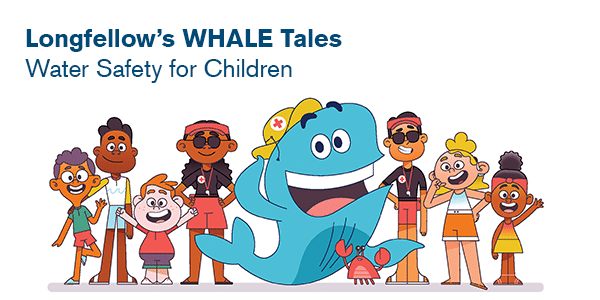Being water smart means knowing how to behave safely when in, on and around the water — and knowing what to do in a water emergency — so you can help prevent a dangerous situation from happening.
The Red Cross has been involved with water safety for over 100 years. Since adding drowning prevention to its mission in 1914, the Red Cross has helped to reduce accidental drownings by nearly 90% nationwide.
As part of this work, more than 2.5 million people every year learn to swim using Red Cross lessons. But swim lessons are just one part of the water safety equation. That’s why we created the free Longfellow’s WHALE Tales Water Safety for Children program, helping children from all backgrounds in kindergarten through 5th grade learn vital water safety behaviors without having to be at a swimming pool.

The Red Cross WHALE Tales program, which stands for Water Habits Are Learned Early, is named in honor of Commodore Wilbert E. Longfellow who started the Red Cross Lifesaving Corps in 1914.
The WHALE Tales themselves are short, engaging and age-appropriate lessons that cover important water safety topics in different environments such as pools, waterparks, oceans, lakes and rivers. Each lesson centers on a memorable rhyming phrase to help kids retain what they’ve learned.
You can be a safety champion this summer by discussing water safety with the entire family before heading out to the water. Here is a sneak peek at some of the lessons that Longfellow the Whale is teaching.
Don’t Just Pack It, Wear Your Life Jacket.
Sometimes, it’s fun to go underwater and see things from a whale’s point of view, and sometimes it’s much better to just stay on top of things, at the water’s surface. A life jacket can give you the ability to float, especially if you are still learning how to swim or if you are in a boat.
Wave, River or Tide, Water Smarts Are Your Guide.
Swimming can be different in oceans, lakes, ponds or rivers. Even a wave pool or a winding river ride at a waterpark is only similar to being in the actual ocean or a river. At a waterpark, the rides are controlled by people, but nature is much less predictable, so be aware and remember your water smarts.
Reach or Throw, Don’t Go.
Lifeguards are taught how to use special rescue techniques and equipment to help save a person who is in danger of drowning. They also learn how to safely enter the water to go help the person. This is their job. If you see someone in trouble, first tell an adult. Look for other ways to help someone without going into the water yourself, such as life rings and reaching poles.
Swim as a Pair with a Lifeguard There.
One of the key water safety rules is to never swim alone and never go into water without permission and supervision of an adult. As the WHALE Tale teaches you, lifeguards are an important part of your water safety team, but you should also have designated adult water watchers. Unlike lifeguards, who are responsible for everyone at an aquatic facility, your water watcher is there just for you and your group. And don’t forget about you — with your newfound water smarts, you are an important part of the team, too.
Parents and caregivers can teach children to be water smart with WHALE Tales anytime, anywhere. All the information about this free program can be found at redcross.org/watersafetyforkids.
Teachers and youth leaders can also get free downloadable resources including lesson plans, course presentations and engaging materials such as videos and activity sheets by visiting redcross.org/WHALEtales.
